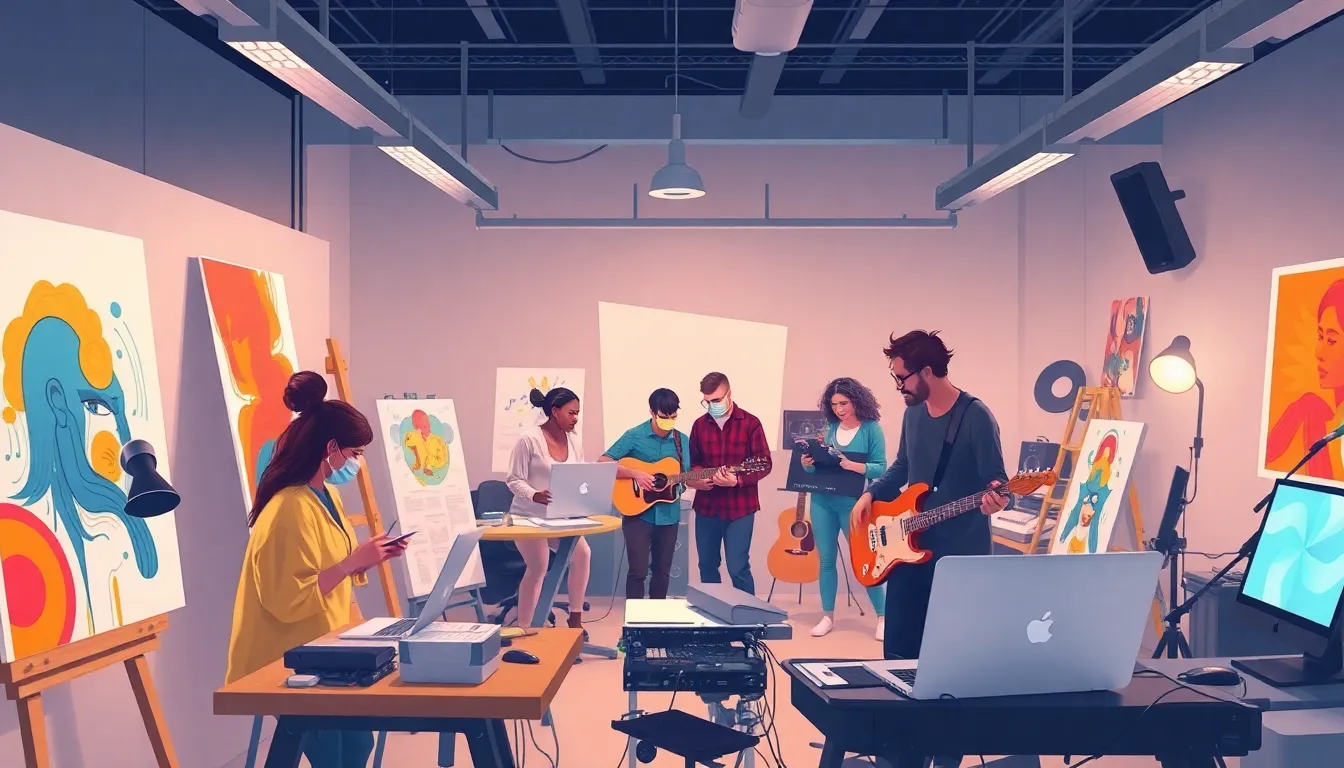Table of Contents
ToggleGenerative AI is shaking things up in the tech world, and it’s not just another buzzword to toss around at parties. Imagine a machine that can whip up a novel, compose a symphony, or even design a killer outfit—all while you sip your coffee and contemplate life’s biggest questions. This isn’t science fiction; it’s the dawn of a new era where creativity and technology collide in the most fascinating ways.
As businesses scramble to harness its powers, generative AI isn’t just a tool; it’s becoming a creative partner. From generating marketing content to crafting personalized customer experiences, this technology is redefining the rules of engagement. Buckle up, because the ride into the future of creativity is just getting started, and it promises to be both thrilling and a little bit hilarious.
Overview of Generative AI
Generative AI represents a significant advancement in technology. This field involves algorithms capable of creating content across various mediums.
Definition and Concepts
Generative AI refers to AI techniques that generate text, images, music, and other forms of content. It utilizes algorithms like neural networks to interpret input data, producing innovative outputs. Popular models include Generative Adversarial Networks (GANs) and Transformer architectures, which enable the creation of unique content. These algorithms learn from massive datasets, capturing patterns and structures. The applications span multiple sectors, including art, marketing, and entertainment.
Historical Context
Generative AI has roots tracing back to the 1950s with early AI efforts. Progress accelerated in the 1990s as computational power improved. Recent developments have redefined capabilities, driving innovations in deep learning. The release of notable models such as OpenAI’s GPT series and DALL-E marked turning points. These advancements demonstrated generative AI’s potential for creativity and practical uses. As adoption continues, industries embrace these technologies for enhanced customer engagement and content creation.
Applications of Generative AI

Generative AI transforms numerous industries through its innovative capabilities. Applications range from content creation to art, design, and music generation.
Content Creation
Generative AI enhances content creation across various platforms. Marketers leverage it to develop engaging articles, advertisements, and social media posts. Writers use AI tools for brainstorming ideas and generating drafts, streamlining their workflow. Brands benefit from personalized marketing messages crafted by AI, increasing audience appeal. Businesses also rely on AI-generated insights to shape their strategies. By automating repetitive tasks, teams focus more on strategy and creativity. According to a study by McKinsey, companies that integrate AI into content creation can boost productivity by over 20%.
Art and Design
Art and design industries experience a renaissance with generative AI. Artists utilize AI algorithms to create unique paintings and graphics, pushing the boundaries of creativity. Designers incorporate AI-driven software to generate logos and branding elements, enhancing visual appeal. This technology allows for rapid prototyping, making it possible to explore numerous iterations quickly. Collaborations between human artists and AI yield innovative artworks that blend different styles. A report from Adobe highlights that 60% of creative professionals see AI as a valuable partner in their creative process.
Music Generation
Music generation has evolved through the capabilities of generative AI. Composers experiment with AI systems that produce original melodies and rhythms. Many artists embrace AI tools to assist in songwriting, finding inspiration in AI-generated compositions. Streaming services also employ generative AI to curate personalized playlists, enhancing user experience. By analyzing listener preferences, AI generates music that aligns with individual tastes. A report from the International Federation of the Phonographic Industry reveals that AI-generated music is gaining traction, with over 30% of music producers using AI in their work.
Benefits of Generative AI
Generative AI offers substantial advantages that enhance productivity and creativity across various industries. Companies increasingly rely on this technology to transform their operations and output.
Increased Efficiency
Generative AI streamlines content creation processes. Marketers save time by automating the generation of articles and advertisements. Tasks once requiring extensive hours now take minutes, allowing teams to focus on strategy. Industries such as gaming utilize AI to create expansive virtual worlds rapidly. Projects that previously needed numerous artists and developers can now be executed faster using AI algorithms. Businesses achieve significant cost reductions by improving operational workflows while maintaining quality. With AI handling repetitive tasks, professionals dedicate more time to innovative thinking and problem-solving.
Enhanced Creativity
Creativity flourishes through the collaboration between human ingenuity and generative AI. Artists leverage AI tools to explore new styles and techniques, expanding their artistic horizons. Designers experiment with novel concepts that combine traditional methods with AI-generated ideas. Musicians discover fresh sounds and compositions by collaborating with AI systems. Content creators gain a partner in innovation, resulting in unique outputs that captivate audiences. This fusion of technology and creativity fosters an environment where experimentation thrives, leading to the emergence of groundbreaking works.
Challenges and Ethical Considerations
Generative AI presents several challenges and ethical dilemmas, particularly in relation to misinformation and intellectual property.
Misinformation and Deepfakes
Misinformation spreads rapidly through generative AI technologies. Deepfakes, which manipulate images and videos, pose serious threats to personal credibility and societal trust. These fakes can fabricate events or statements, leading to potential misinformation crises. As generative AI empowers creators to produce realistic content, the line between truth and fiction blurs. Notable instances include falsified videos of public figures that circulate online, impacting public opinion and decision-making. Organizations, including media outlets, work to combat these challenges through verification technologies and raising public awareness.
Intellectual Property Issues
Intellectual property rights come under scrutiny with the rise of generative AI. Creators often generate content based on existing works, leading to potential copyright violations. Legal frameworks struggle to keep pace with advancements in AI, creating ambiguity around ownership of AI-generated content. Various artists voice concerns about the originality and protection of their work, as algorithms learn from their creations. Some countries consider legislation to address these gaps, but differences in enforcement complicate the landscape. Stakeholders advocate for clearer guidelines to ensure fair practices and protect creators’ rights in an evolving digital ecosystem.
Future of Generative AI
Generative AI continues to evolve rapidly, presenting new opportunities and challenges across various sectors. Businesses increasingly adopt this transformative technology, guiding innovations in content creation and customer engagement.
Emerging Trends
Increased interactivity defines a key trend in generative AI. Users expect more personalized experiences across platforms. Enhanced natural language processing capabilities enable more human-like interactions. Developers integrate generative AI into virtual and augmented reality, creating immersive experiences that blend real and digital worlds. AI-assisted design tools gain traction as artists leverage these innovations to streamline workflows. These developments foster collaboration between creatives and AI systems, resulting in unique outputs that push artistic boundaries.
Potential Impact on Society
The societal impact of generative AI extends to various domains. Enhanced educational tools emerge, allowing personalized learning experiences tailored to individual needs. As workplaces adopt AI tools, productivity increases alongside significant shifts in job roles. Ethical considerations accompany these advancements, with a strong focus on misinformation mitigation. By addressing these issues, stakeholders aim to safeguard public trust and ensure responsible use of technology. Communities must engage in ongoing discussions about the implications of AI-generated content, establishing guidelines that protect creators’ rights while promoting innovation.
Generative AI is reshaping creativity and content creation across various industries. As businesses embrace this technology, the collaboration between human creativity and AI is opening new avenues for innovation. While the benefits are substantial, ethical considerations and challenges must be addressed to ensure responsible use. The future promises exciting developments as generative AI continues to evolve. Stakeholders must remain vigilant in navigating the complexities of this technology while harnessing its potential. The journey ahead is filled with opportunities for enhanced creativity and engagement, making it a pivotal moment in the digital landscape.




